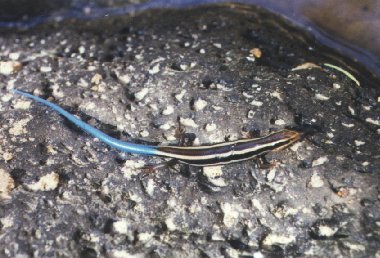| |
Western Skink
 |
 |
 |
|
|
| The western skink (Eumeces skiltonianus)
occurs throughout much of the western United States, as well as in parts
of Baja California and southwestern Canada. In Utah, the species occurs
in the western part of the state, where it is usually found in scrub
oak, sagebrush, grassland, or juniper habitats. Western skinks are
active during the day, but are rarely seen due to their secretive
nature. Young western skinks have bright blue tails. The general
consensus is that this attracts the attention of predators towards the
tail and away from the head and body. The tail breaks off easily and
twitches for a period of time. This draws the attention of predators to
the tail and often allows the skink to escape an attacking bird, snake,
or larger lizard. |
| |
 |
Natural
History |
 |
|
Western skinks eat a variety of
invertebrates, including insects, spiders, and worms. Body color fades
with age and molts. The tails of adults range from light blue to very
light powder blue to gray.
 Tails
of the males are usually brighter blue than females, although tails in
both sexes of adults are not as bright as those of the juveniles. Tails
of the males are usually brighter blue than females, although tails in
both sexes of adults are not as bright as those of the juveniles.
|
The western skink at right is
likely an adolescent. |
The western skink reaches sexual maturity at age two,
but begins actively breeding at about age three. The oldest animals
found are believed to be about nine years old. Males and females live
separately. Females nest on south facing rocky hills, under rocks in the
open, or under rocks that are partially covered by sage, oak or
junipers. Under these rocks, the female digs loose moist earth burrows.
Males live nearby females, under rocks in short tunnels rather than an
enlarged burrow. The breeding season is May through June. In July,
females lay one clutch of eggs with two to six eggs in a clutch. The
young hatch in August. The female stays with her eggs and hatchlings,
fiercely guarding them until they are old enough to leave the burrows. |
Back to Flora & Fauna |
|

